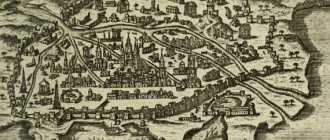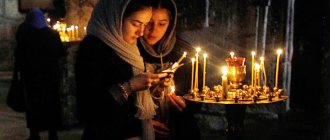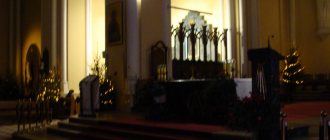The Creed is a summary of the entire essence of Orthodoxy. The dogmas presented in the form of church verses differ from other Christian movements (for example, from the Catholic one). That is why it is so important for godparents to know this prayer by heart. It is read during the rite of baptism, also at every Liturgy.
About the author About the book
How to learn the creed
The “Creed” prayer is one of the main prayers in the Orthodox faith.
This sacred text is the basis of Orthodox dogma. It includes 12 short statements explaining the essence of the Christian religion. Every Orthodox person should know this prayer by heart in order to always answer what he believes.
Very often, future godparents are far from the church and do not know or understand this prayer. But, be that as it may, during baptism the priest will ask the godparents if they know the “Creed” prayer by heart. Of course, if you do not know the prayer, you will be asked to read it from the prayer book.
The “Creed” prayer is read in Church Slavonic. This imposes additional difficulties when reading. If you cannot learn the prayer by heart, then be sure to read it many times, always out loud and slowly. Be sure to pay attention to the stress in words. Otherwise, when reading the prayer during baptism, you may experience significant difficulties. In our practice, there were cases when the priest again and again asked the godparents to re-read the prayer in full! Because they read with errors, especially at the endings of words.
“Saying the words of prayer slowly, do not allow the mind to wander everywhere, but shut it in the words of prayer.”
St. Ignatius (Brianchaninov)
In order to read and learn the “Creed” prayer well, you first need to carefully read the explanations to the prayer.
If you understand the meaning of the words of the prayer, then half the work will be done. Along with this, you will have an understanding of the foundations of the Christian faith. The brain perfectly remembers words connected associatively. He discards incomprehensible letter combinations like garbage, not wanting to waste time on them. Therefore, for better memorization, you must first parse and understand all new words. Try to feel the word and connect it in your imagination with familiar concepts.
The next step is to find an audio source for the Creed prayer. Listen to the chant and sing along, always out loud. In ancient times, all prayers read were taken from the psalms. But the words “read” are not found anywhere, but “sing” is found everywhere.
Next, you can use various memorization techniques. It all depends on what is closest to you. Try different techniques.
Important! It's easier to remember anything if you tell yourself how important it is.
Due to the fact that the brain remembers mainly only images, you need to create a picture in your head. Clearly visualize all sentences of the prayer. It is recommended to build logical chains. By forming images, you can put the learned plot in your head for a long time. Thanks to the technique, you can very quickly learn the text of the prayer.
Many of us remember everything through the visual channel. Try drawing all the sentences of the prayer as simple drawings. Even if you draw poorly, it doesn't matter. You don't need to show your drawings to anyone, you only need them for memorization. Use circle, square, triangle, straight line and dot. With these simple geometric shapes you can draw anything you want.
In order to connect another type of memory, you need to rewrite the prayer on paper with your own hand. In this case, it is worth saying the prayer out loud. You should not skip this moment, as it will allow you to learn the “Creed” prayer even faster.
To remember something well, you need to repeat it several times, always out loud, slowly, clearly, loudly and with expression.
This will help the brain to concentrate correctly and tune into the necessary mood.
Our brains can be programmed - this is a scientific fact. To achieve a goal, it is necessary to understand it and work daily in the chosen direction. Therefore, if you have firmly decided that it is extremely important for you to learn the Orthodox prayer “Creed,” then your brain is already tuned in to intensive memorization. But, in addition to regular training, regular repetition of the material covered is also important. Use specific time intervals for best memorization: repeat the prayer immediately after studying, then after 15-20 minutes, after 6-8 hours (preferably before bed) and the last time after a week.
You need to directly memorize the prayer only from the sheet of paper on which it was copied. Read the first line several times, and then repeat it out loud, without looking at the sheet. Then you should read the first and second lines together, and then repeat them out loud all together. Next, you should do the same with the first, second and third lines, adding one more each time.
Don't sit still! Learn the text of the prayer by walking in circles around the room. The fact is that walking activates your brain and your ability to remember increases significantly. Also, memory will work well after playing sports: there is a lack of active inhibition and a consequence of physical activity.
Finger exercises for adults are an excellent help for memorizing prayers. Do a set of exercises for three minutes before learning the prayer and you will be surprised how easier it will be for you to learn the text.
About
Prayer "Creed"
I believe in one God, the Father, Almighty, Creator of heaven and earth, visible to all and invisible. And in one Lord Jesus Christ, the Son of God, the only begotten, who was born of the Father before all ages; Light from Light, true God from true God, begotten, uncreated, consubstantial with the Father, to whom all things were. For our sake, man and our salvation came down from heaven and became incarnate from the Holy Spirit and the Virgin Mary, and became human. Crucified for us under Pontius Pilate, and suffered and was buried. And he rose again on the third day according to the Scriptures. And ascended into heaven, and sits at the right hand of the Father. And the one who is to come will judge with glory the living and the dead, His Kingdom will have no end. And in the Holy Spirit, the Lord, the Life-Giving One, who proceeds from the Father, who is with the Father and the Son, we are worshiped and glorified, who spoke the prophets. Into one Holy, Catholic and Apostolic Church. I confess one baptism for the remission of sins. I hope for the resurrection of the dead and the life of the next century. Amen.
A little history
The Creed prayer contains the fundamental foundations of Orthodox Christianity, as well as Christianity in general. Because this ancient text (6th century) is used in the rituals of many Christian movements, including Protestants and Catholics. This is a concentrate of knowledge about faith in general, specifically about God and the Son of God, Jesus Christ.
This prayer is pronounced collectively, that is, by all those present at the church service in the temple, at every divine liturgy. This is one of the ways to learn the “Creed” prayer in 5 minutes, for those who have a good memory.
If you are going to the liturgy for the first time, take a small prayer book with you; you can read the prayer text from it, laying the foundation for memorization. The text of this prayer is included in the morning prayer rule. This is another way to quickly learn the “Creed” prayer, roughly in 5 minutes.
The daily practice of communicating with the Creator through prayer will speed up the process of memorizing not only this prayer.
What does the “Creed” prayer give?
The “Symbol of Faith” helps a person to be closer to the Almighty and to establish a strong connection with him. Her words penetrate deeply into the heart, soul and subconscious, rejuvenating a person, healing him. There have also been cases of resolution of the most difficult situations after regular reading or listening to the audio of this sacred text.
“I Believe” did not immediately acquire the form in which it exists today. Its text was polished century after century, and every word was clearly verified. The main goal of theologians was to convey as accurately as possible the essence of the commandments by which a baptized person should live. It was necessary to convey the whole meaning of Christianity in the short time of the sacrament of baptism, so that a person clearly understood that now his life would be filled with miracles of faith.
After believers realized how powerful this prayer was, they began to use it not only during baptism, but also in moments of anxiety. Thus, they returned to the origins of the origin of the world, felt the love of Jesus Christ for all humanity, and pacified their passions. If you are imbued with the words “I Believe”, you can plunge into a state of some kind of trance, feel like a part of the vast Universe and receive the help of the Creator. By reading or listening to a text before going to bed, you can get an answer to an important question in your dream.
The text “Creed” is one of the three most important prayers: “Our Father”, “Rejoice to the Virgin Mary” and “I Believe”. Each of them brings with it light, goodness, truth, help, protection and peace. Believers around the world confirm the invisible support they receive after reading these three prayers.
Why know the Creed prayer by heart?
To learn the theoretical part, you need constant systematic practice, that is, for each action there is a methodology for its implementation. Prayerful communication is a means, an instrument with the help of which the soul feels the spiritual world.
Finding himself in various extreme situations, a person remembers God. In such cases, any sincere heartfelt words addressed to the Lord will do.
They will also be considered prayer. The “Creed” prayer is a daily affirmation, strengthening of one’s faith and fidelity to the Heavenly Father and His Laws.
Therefore, it is necessary to pay attention to the depth of the text of this prayer. Understand each postulate that points to the strength, power, and mercy of the Creator. Memorizing the text of the “Creed” prayer without understanding the essence will not lead to the desired result.
The reason is very simple. God does not need cram students and “excellent” students, for He came to sinners. That is why the saints did not consider themselves as such. But this does not mean that nothing needs to be done, studied, learned.
On the contrary, only internal certainty - if we want to return Home, to be with God in eternal joy - gives us the opportunity to become His disciple. Take the Christian path of returning to the Father.
Holy text of prayer
I believe in one God the Father, Almighty, Creator of heaven and earth, visible to all and invisible. And in one Lord Jesus Christ, the Son of God, the only begotten, who was born of the Father before all ages; Light from Light, true God from true God, born, uncreated, consubstantial with the Father, to Whom all things were. For our sake, man and our salvation came down from heaven and became incarnate from the Holy Spirit and the Virgin Mary, and became human. She was crucified for us under Pontius Pilate, and suffered and was buried. And he rose again on the third day according to the Scriptures. And ascended into heaven, and sits at the right hand of the Father. And again the coming one will be judged with glory by the living and the dead, His Kingdom will have no end. And in the Holy Spirit, the life-giving Lord, who proceeds from the Father, who is worshiped and glorified with the Father and the Son, who spoke the prophets. Into one Holy, Catholic and Apostolic Church. I confess one baptism for the remission of sins. I hope for the resurrection of the dead and the life of the next century. Amen.
Interpretation of the sacred text
The Church has kept the “Creed” since apostolic times and will keep it forever.
Each of the 12 parts of the doctrinal text has its own meaning:
- We believe in God, the Creator of all living and inanimate things, Heaven and Earth, everything visible and invisible. The entire Universe revealed to humanity is a generous Gift from the Heavenly Father.
- The Son of God, born of God the Father, is His continuation, has a human image and nature. He is the second Person of the Great Holy Trinity.
- The Lord came down from Heaven to Earth and for the sake of saving us, sinful people, became a man.
- Jesus Christ, the Son of God, our Savior, took upon himself the sins of mankind to atone for them, for which he was crucified on the Cross.
- After the terrible Crucifixion, on the third day He miraculously rose again.
- Jesus, after His Ascension, took a place next to His Father at the Heavenly Throne.
- The reign of the Great Trinity - Father, Son and Holy Spirit - will be eternal and will never end. The Lord will judge us, righteous and sinners, according to our repose in Heaven.
- The Holy Spirit gives life to everything on Earth and speaks to people through the prophets.
- A person living in Christ must believe in the One Holy, Catholic and Apostolic Church.
- Every Orthodox Christian is obliged to accept the Sacrament of Holy Baptism, otherwise there is no way for him to enter the Kingdom of Heaven, to its Paradise abodes. During the celebration of the Sacrament, the person being baptized is immersed three times in consecrated water, thereby the person dies to a sinful life and is born to a spiritual life.
- All the dead will be resurrected during the Second Coming of Christ to Earth, and each of them will be assigned by God a “deserved” place in Heaven - heaven or hell, eternal torment or endless joy and life with Christ. The resting bodies will unite with the souls and will be immortal.
- Completion of prayer, forgiveness of sins and faith in eternal life in the heavenly abode. Amen! - means “truly, so be it!”
Theological meaning
Initially, Christianity did not have a prayer that briefly outlined its dogmas. Because there were few believers, they all knew the confession firmly - after all, preparation for Baptism in the first centuries of our era lasted for years (sometimes up to 10 years). But the number of followers grew, and incorrect interpretations—heresies—appeared. For example, the Arians argued that Jesus Christ was created and is not consubstantial with God the Father. There were many other distortions. Then the heads of the churches decided to draw up a verbal formula for the foundations of Christianity . Let's look at the meaning of each part of the Creed .
Qualities of the Creator
The first verse proclaims the unity of God, who created all things. These assertions are now actively refuted by ecumenists. They say: the Lord of all religions is the same, so it makes no difference what and how to believe. But this is just a cunning trick to justify the unwillingness to live according to the commandments given in the Bible. The theory of evolution also contributes to the destruction of Christianity. She accuses the Holy Scriptures of lying, and makes a person valuable in himself. But the life of a believer has meaning and depth only in unity with God.
Theological dogmas about Christ
Modern people find it difficult to trust their feelings . They are trained to listen only to reason. Therefore, the divine-human nature of Christ becomes a stumbling block for many. Reason is able to recognize Jesus only as a perfect man - a moral teacher, a humble preacher. But faith is also a test that God sends. And the dogma is unambiguous - the Son of God is God, while at the same time being fully human.
Incarnation of the Virgin and the Holy Spirit
Here we are talking about the implementation of a plan to save the descendants of fallen Adam. Also an important part of the confession is belief in the virgin birth. Christ was born without male seed, taking human nature entirely from Mary. Thus He was free from Adam's sinful nature. Christ has all human needs (in earthly life He needed to sleep, drink, eat food, He felt pain and mental anguish), but is devoid of any passion. The idea of the incarnation of Jesus as the Savior is well expressed in A. Rublev's Trinity.
Crucifixion of Christ, mention of Pontius Pilate
It may seem strange why mentioning the name of the person who sent Jesus to the crucifixion is necessary. In fact, this is very important - in this way the Church points out the historicity of not only the crucifixion, but also other events associated with it. There is also a moral lesson here. The procurator who condemned Christ was free to release Him. But Pilate was afraid. He acted on his fears. Fearing for his career, he sentenced an innocent man to death. After all, if Caesar’s governor had released the suspect, unrest could have broken out, and denunciations to the Romans would certainly have followed.
Freedom of conscience given to a person is not only his right, but also his responsibility. Pilate was given power by God - he must protect the offended and assert justice. The freedom to choose between good and evil is given to everyone. How to dispose of it is up to the individual himself to decide. Because the Creator does not want blind submission. He wants people to voluntarily choose the light. But remember that there will be consequences.
Victory over death
The resurrection of the dead God is an idea unique to Christianity. It could not have originated either in Judaism (after all, it was the inhabitants of Judea who demanded the crucification of Jesus), or in any other religion. The Holy Fathers consider the resurrection of Christ one of the proofs of the divine origin of their faith. The death and subsequent resurrection of Jesus was the fulfillment of biblical prophecies about the Savior.
Ascension of Jesus
After the resurrection, the Lord appeared to the apostles several times and taught them a correct understanding of Scripture. After He told the disciples to take the gospel message to every corner of the earth, Christ ascended to the Father.
Return of Christ to earth, final judgment
The second coming will mean the completion of world history . It is then that the final judgment of people will take place. Before this, all the dead will be reunited with their bodies. People will also be given back their will, the opportunity to determine their relationship with the Creator. Sinners will be condemned to eternal torment, the righteous will have eternal glory and abiding with God.
One of the basic truths of Christianity is proclaimed - the Creator is immortal, thanks to Him the human soul is eternal. Everyone, regardless of religion, skin color and other individual characteristics, awaits not only physical death, but beyond it eternal life. Therefore, every person is obliged to think about how it will pass now, while his stay on earth lasts.
About the Holy Spirit and the Trinity
One of the most complex dogmas of Christianity is the trinity of God . The human mind cannot understand how one God can combine three full-fledged Persons. The eighth term makes it clear that all three Persons of the Trinity are equal. There are still disputes between Catholics and Orthodox about the procession of the Holy Spirit (in the Western Church there is the doctrine of Filioque - “and from the Son,” which formally is one of the reasons for the great schism).
About the unity of the Church
By and large, the Church is not a building, but a unity of believers. People who consciously profess Christianity and gather for prayer are the Body of the Church. Every follower of Christ is called to apostolic service - with his life he must testify to the Savior.
About the need for baptism
To inherit the Kingdom of God, it is necessary to undergo the Sacrament of Baptism , as the Savior did. The church ceremony indicates that a new life begins, completely subordinate to the Commandments. The old sinner dies, a renewed soul is born, life from now on must be spiritual.
Waiting for a new life
Resurrection awaits everyone, regardless of faith. According to church tradition, after this the body will be devoid of any physical defects, and the soul will appear in its true form. It will no longer be possible to avoid the voice of conscience, which can now be drowned out by entertainment or vain affairs. Orthodox monks teach that already in this life people can see the radiance of eternal glory, which the children of Adam will be able to fully perceive only after the end of their temporary existence. To do this, it is necessary to lead church life - to pray, to participate in rituals.
About eternity
Trust in endless existence radically changes behavior and attitude towards every event. A Christian checks his actions against biblical principles so as not to commit sins that will prevent him from entering heaven.
Every new day brings its joys and disappointments. Any mortal from time to time indulges in sad thoughts, sometimes even sins. But faith does not allow a person to completely forget about his high calling. It makes you get up off your knees and strive for the best again. After all, he is not just dust of the earth, but a child of God. The Lord loves everyone, waits and calls to Himself. This is what the summary of dogmas, written in the form of 12 verses, reminds us of.
Creed Prayer for Baptism
Origin of the prayer text
The text of the prayer contains a confession of the Christian Orthodox faith, its truths, dogmas and all basic provisions. With its help, newly converted Christians prepare to receive the Sacrament of Baptism.
Previously, in ancient times, there were several short “Creeds”. They were called upon to remind those being baptized of what they believe in and what they bring to the world. But at the same time, false teaching about God was actively spreading throughout the world. That is why a more precise and dogmatically flawless text was compiled a little later. It has grown and acquired a modern appearance.
An updated version of the prayer was compiled at the Councils in 325 and 381, and is used by the entire Orthodox Church.
1 The Council was convened in Nicaea regarding the spread of false teaching about Christ by the presbyter Arius. He argued that Jesus was created by God the Father but was not the Supreme Creation. In condemnation of the Aryan assertion, the first seven dogmas of the Prayer were composed.
Interesting about Orthodoxy:
At the 2nd Council, the heresy of Macedonius, who denied the Divinity of the Holy Spirit, was condemned. As a result of the rejection of his lies by the Assembly, the following lines of prayer were given.
When to say a prayer
It is recommended to read the Creed after waking up and before going to bed.
The Creed prayer is very important in the Christian faith and is sung at every church service. Many people are familiar with its text. Most often in church this prayer is sung in chorus.
Also, in addition to church services, this glorifying prayer should be read before going to bed and in the morning, after waking up, as soon as you wake up.
The words of the prayer do not have to be learned by heart. You can read it in a chant or simply, like a regular text from a sheet. The main thing here is not to be distracted by anything and fully concentrate on the words of the prayer and on the deep meaning that is inherent in it.
It will become a kind of reminder of what a person believes in.
Read this prayer when you feel that your faith has been shaken, when you suddenly stop believing in the highest good and light.
It will protect you from unbelief and all kinds of temptations, acting as a kind of shield.
The meaning of this prayer has very strong resonances with the “Our Father.”
Prayer “Creed” - godparents need to know it by heart
Preparation for the Sacrament of Baptism is a very important time in the life of future godparents. During the catechetical conversations, the rite of Baptism is described in great detail, as well as what the recipient must know. The “Creed” also falls into this category.
At its core, the Creed is not a prayer. There is no appeal, no prayer request to God, the Mother of God or the Saints. The “Creed” contains a brief and very precise statement of the foundations of the entire Christian doctrine, which was compiled and approved at the First and Second Ecumenical Councils.
The “Creed” must be learned by godparents by heart, since during Baptism it is pronounced by the recipients in the church. But it is very important not only to learn, but also to understand what is said in the prayer.
1 I believe in one God, the Father, Almighty, Creator of heaven and earth, visible to all and invisible. 2 And in one Lord Jesus Christ, the only Son of God, begotten of the Father before all ages; Light from Light, true God from true God, born, uncreated, consubstantial with the Father, to Whom all things were. 3 For our sake, man and our salvation came down from heaven and became incarnate from the Holy Spirit and the Virgin Mary, and became human. 4 She was crucified for us under Pontius Pilate, and suffered and was buried. 5 And he rose again on the third day according to the Scripture. 6 And ascended into heaven, and sits at the right hand of the Father. 7 And the one who is to come will judge with glory the living and the dead, whose kingdom will have no end. 8 And in the Holy Spirit, the Lord, the Life-Giving One, who proceeds from the Father, who is with the Father and the Son, is worshiped and glorified, who spoke the prophets. 9 Into one Holy, Catholic and Apostolic Church. 10 I confess one baptism for the remission of sins. 11 I look forward to the resurrection of the dead, 12 and the life of the world to come. Amen.
History of Prayer
There is one in the collection of prayers that is not like the rest. There are no appeals to God, requests for anything, as well as gratitude or repentance. The first word is “I believe,” and it is followed by a long list of what Orthodox Christians believe.
Its name is laconic - “Creed”. It was compiled in the 4th century. Holy Fathers of the I and II Ecumenical Assembly. Since that time it has not undergone any changes. It contains all Christian truths.
In all parts of the prayer there is an exposure of errors and misinterpretations of Christianity.
Text of the prayer “Creed”
In Russian
- I believe in one God, the Father, Almighty, Creator of heaven and earth, of everything visible and invisible.
- And in one Lord Jesus Christ, the Son of God, the Only Begotten, begotten of the Father before all ages: Light from Light, true God from true God, begotten, not created, one being with the Father, by Him all things were created.
- For the sake of us people and for the sake of our salvation, he came down from heaven and took flesh from the Holy Spirit and the Virgin Mary, and became a man.
- He was crucified for us under Pontius Pilate, and suffered, and was buried.
- And rose again on the third day, according to the Scriptures.
- And ascended into heaven, and sits at the right hand of the Father.
- And He will come again with glory to judge the living and the dead; His Kingdom will have no end.
- And in the Holy Spirit, the Lord, the giver of life, who proceeds from the Father, worshiped and glorified with the Father and the Son, who spoke through the prophets.
- Into one, Holy, Catholic and Apostolic Church.
- I recognize one baptism for the forgiveness of sins.
- I look forward to the resurrection of the dead.
- And the life of the next century. Amen (truly so).
In Church Slavonic
- I believe in one God, the Father, Almighty, Creator of heaven and earth, visible to all and invisible.
- And in one Lord Jesus Christ, the Son of God, the only begotten, who was born of the Father before all ages; Light from Light, true God from true God, begotten, uncreated, consubstantial with the Father, to whom all things were.
- For our sake, man and our salvation, who came down from heaven and became incarnate from the Holy Spirit and the Virgin Mary and became human.
- Crucified for us under Pontius Pilate, and suffered and was buried.
- And he rose again on the third day according to the Scriptures.
- And ascended into Heaven, and sits at the right hand of the Father.
- And the one who is to come will judge with glory the living and the dead, His Kingdom will have no end.
- And in the Holy Spirit, the Lord, the Life-Giving One, who proceeds from the Father, who is with the Father and the Son, we are worshiped and glorified, who spoke the prophets.
- Into one Holy, Catholic and Apostolic Church.
- I confess one baptism for the remission of sins.
- Teaching the resurrection of the dead,
- and the life of the next century. Amen.
The entire Creed consists of twelve members (sentences), and each of them contains a special truth, or, as they also call it, the dogma of our Orthodox faith.
The 1st member talks about God the Father, the 2nd to 7th members talk about God the Son, the 8th – about God the Holy Spirit, the 9th – about the Church, the 10th – about baptism, the 11th and 12th -th - about the resurrection of the dead and eternal life.
What does the text say and why study it?
The Creed consists of 12 parts. Each is a complete dogma that follows one after another, showing the history of the universe in dynamics - from the creation of the world to the Last Judgment. If you understand the internal logic, it will be much easier to remember.
In its current form, the Creed prayer was approved only at the end of the 5th century, mainly to avoid various heresies. Before this, various forms were used for baptism, but were not approved by the Councils.
Work as a courier at Yandex.Eda (up to 3,400 rubles per shift) leave a request →
Of course, children are not able to understand, much less learn, the Church Slavonic version of the Creed prayer. This is why the presence of godparents is necessary on such a decisive day. They take upon themselves the responsibility of reading prayers, which the baby must learn when he grows up. There is no “children’s” version of the Creed; this is a condensed and rather short presentation.
- Verse 1 talks about the qualities of God in whom the Christian church believes. What is said here refers to God the Father. It was He who created everything out of primeval chaos. “Heaven and earth” here denote not only the universe, but also spiritual and physical reality.
It is highly advisable for a godfather to not just memorize a prayer because the priest said so. The Creed must be understood in order to teach the godson in the future. After all, this is what successors are needed for, and not just for the sake of nepotism.
- Verse 2 explains the properties of Christ as God, explaining his inextricable connection with the Father. The dogma of the Trinity is one of the most complex; it cannot be understood by logic alone. What is needed here is faith, which will help us understand how three persons can remain one. Moreover, each of them has its own characteristics.
- Verse 3 talks about the Incarnation. A very important postulate that says that the Old Testament prophecies came true in Christ. This is also what the New Testament affirms. The Son of God, appearing in the flesh, completely and forever changed the relationship between God and man.
To learn the necessary prayers, you will have to work hard, “use your brain” - but this is the responsibility of godparents. If you don’t have enough strength even for such a task, perhaps you shouldn’t take responsibility for the spiritual upbringing of your child.
- Verse 4 tells about the crucifixion and suffering of the Savior on the cross. There is both historicity and deep theological implications here. After all, without this terrible sacrifice, people would not be able to get to heaven.
- Verse 5 - after the sadness that befell the disciples after the Crucifixion, the joy of the Resurrection awaited them, which is discussed here, and very briefly.
- Verse 6 tells what happened to Jesus after the Resurrection. At this time, He is in the abodes of the heavenly Father, where He ascended before the eyes of the apostles on the day of Pentecost.
- Verse 7 - it already talks about the future - about the Last Judgment, at which all humanity will be judged.
- Verse 8 is dedicated to the Holy Spirit and its properties.
There were also desperate theological debates about Him. Until now, there is no agreement between Catholics and Orthodox on this issue - namely, on the question of from whom He comes.
- Verse 9 proclaims the role of the Church in the work of salvation. In all classical movements, Christ Himself is recognized as the head of the Church.
- Verse 10 - here we are talking about the Sacrament of Baptism, which washes away all sins.
- Verses 11 and 12 complete Christian eschatology. After all, the present world, according to the teachings of Christ, is finite, just like earthly human life. To remind people of this is the sacred duty of the Church.
If you spend a little time looking at each verse, the Creed will not be so complicated.
The Origin of the Creed Prayer
The Creed began as a preparation for converts about to be baptized. In ancient times, as a rule, adults were baptized. Just like today, everyone became a church member as a result of his own, precisely his own path. Since any conversion, any contact of a person with God is a secret of divine providence, the veil of which we are not allowed to open. Someone is looking for God, overwhelmed with misfortunes, in trouble. Others find God by seeing him as the light of joy and grace.
The emergence of faith in the human soul is a mystery. But, nevertheless, faith in Christ is a person’s path to the Church, to the community of believers in Christ. It is faith that strives and calls for the unification of believers, who, precisely by their unity and love for one another, show the world that they are followers of Christ.
The life of a new believer as a Christian began with his visit to the bishop of the local Church, and he put a cross on his forehead, as if denoting the sign of Christ. The man came to God and believed in Christ. But now he is supposed to find out the content of faith. He turns into a student. According to church scriptures, they begin to announce it. Since Christianity is not just a feeling, but an encounter with the Truth, a difficult feat of accepting it entirely. As if a person who has a passionate love for music, in order to play an instrument, is obliged to master difficult training, similarly, one who has believed in Christ and loved him, must now realize the depth of his faith and what it calls for.
On the eve of the celebration of Easter - because in the early Church they were baptized on Easter night - anyone about to be baptized solemnly read the words of the prayer “Creed”, making a “giving” of it, accepting their entry into the unity of faith and love. Every major church there—Roman, Antioch, and so on—had its own creed for baptism. And even though they were everywhere an expression of a single and indivisible faith, stylistics and phraseology, they differed.
The role of Ecumenical Councils
In the first half of the 4th century, serious discussions broke out in the Church regarding the basic Christian doctrine of Christ as God. In the 20s of the 4th century, the first Ecumenical Council was convened in the city of Nicaea, and at it a common Creed, identical for all Christians, was drawn up. A few decades later, at the Second Ecumenical Council in Constantinople, the Creed was supplemented and given the name Nicene-Constantinople, one for the universal Church. And the third, the Ecumenical Council, in Ephesus in the 30s of the 5th century, proclaimed that this symbol was preserved forever inviolable, so that it would not be supplemented further.
Since that time, the ecumenical Creed has been sung or read in the Church at any liturgy. He is the Church’s common and indispensable expression of its faith. And for this reason, anyone who wants to find out what the Church believes in, what is the essence of the Christian faith, what is the Truth conveyed by Christianity to the world - will find the answer in the prayer “Creed”.









